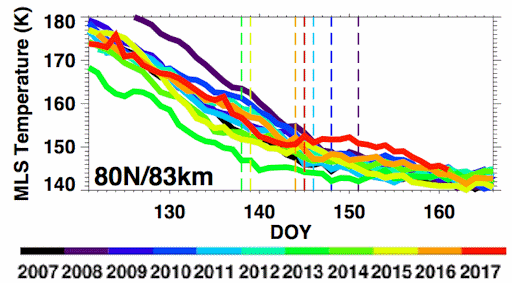15.06.2017
MYSTERY OF THE MISSING NOCTILUCENT CLOUDS: In late May 2017, observers in Europe began seeing electric-blue tendrils snaking over the western horizon at sunset. The summer season for noctilucent clouds (NLCs) was apparently beginning. Normally, the strange-looking clouds surge in visibility in the weeks immediately after their first sighting. This year, however, something mysterious happened. Instead of surging, the clouds vanished. During the first two weeks of June 2017, Spaceweather.com received ZERO images of NLCs -- something that hasn't happened in nearly 20 years.

Where did they go? Researchers have just figured it out: There's been a "heat wave" in the polar mesosphere, a region in Earth's upper atmosphere where NLCs form. Relatively warm temperatures have wiped out the clouds.
Lynn Harvey of the University of Colorado's Laboratory for Atmospheric and Space Physics made the discovery using temperature data from the Microwave Limb Sounder onboard NASA's Aura satellite. "In early May, the summer mesosphere was cooling down as usual, approaching the low temperatures required for NLCs," she says. "But wouldn't you know it? Right after May 21st the temperature stopped cooling over the pole! In fact, it warmed a degree or two over the next week. The warming resulted in 2017 being the WARMEST summer mesopause in the last decade."
She is describing the red curve in this 10-year plot of polar mesospheric temperature trends:

Warm temperatures are an anathema to NLCs. The icy clouds form 83 km above Earth when the air temperature drops below 145 K (-128 C), allowing scarce water molecules to get together and crystallize on specks of meteor smoke. Even a couple of degrees of warming is enough to obliterate the fragile clouds.
"We don't know why the mesosphere warmed up," says Cora Randall, Professor and Chair of the University of Colorado Department of Atmospheric and Oceanic Sciences. "It's probably a complex process involving the propagation of atmospheric gravity waves, which affect the flow of air and heat in the upper atmosphere. We're looking into it."
Meanwhile, the heat wave may be coming to an end. "In the last week, the north polar mesopause has started cooling again," says Harvey. This means NLCs should soon return, bouncing back to normal as temperatures drop. High latitude sky watchers should be alert for electric-tendrils creeping out of the sunset in the nights ahead--and if you see anything, submit your pictures here!
Quelle: Spaceweather
